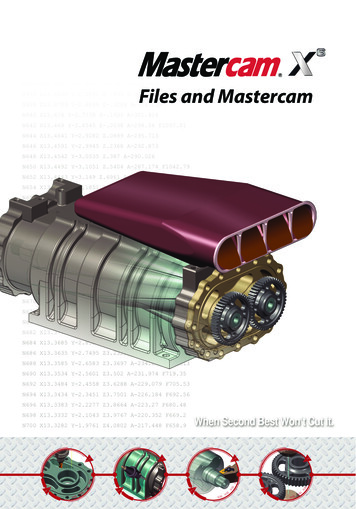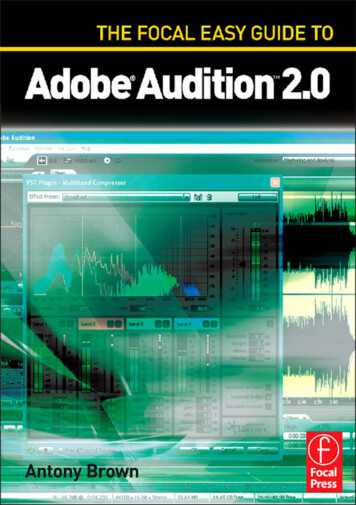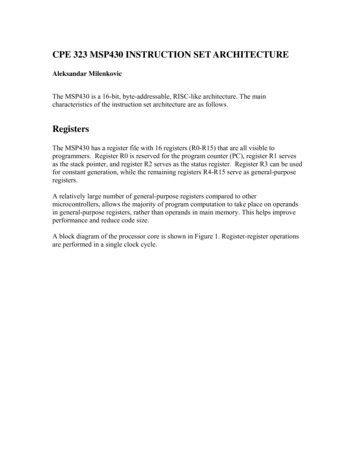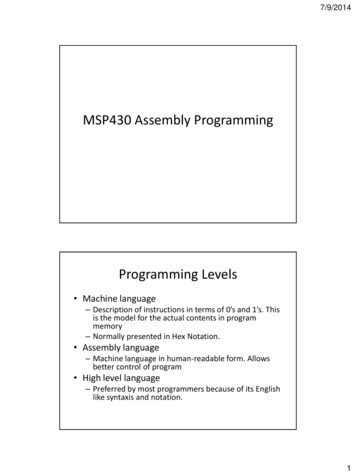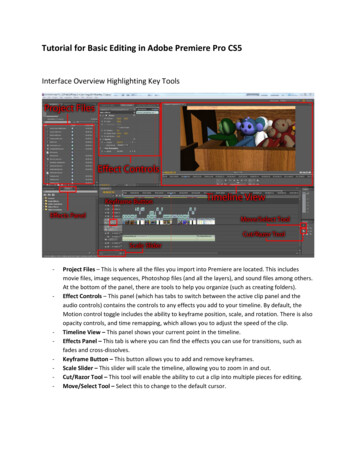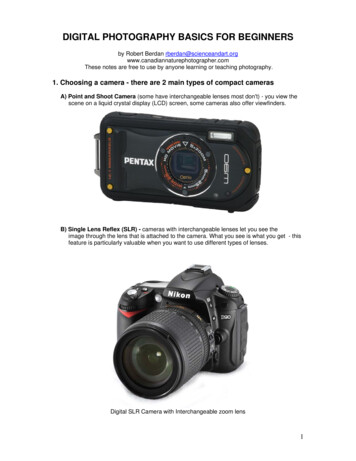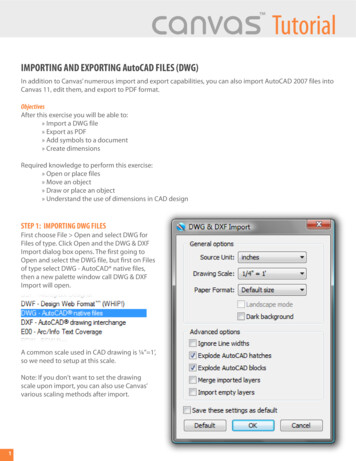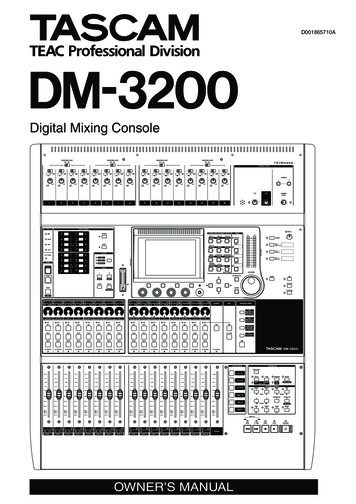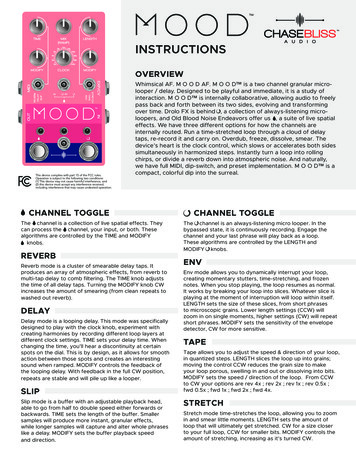
Transcription
INSTRUCTIONSOVERVIEWThis device complies with part 15 of the FCC rules.Operation is subject to the following two conditions:(1) This device may not cause harmful interference, and(2) this device must accept any interference received,including interference that may cause undesired operation.Whimsical AF. M O O D AF. M O O D is a two channel granular microlooper / delay. Designed to be playful and immediate, it is a study ofinteraction. M O O D is internally collaborative, allowing audio to freelypass back and forth between its two sides, evolving and transformingover time. Drolo FX is behind , a collection of always-listening microloopers, and Old Blood Noise Endeavors offer us , a suite of live spatialeffects. We have three different options for how the channels areinternally routed. Run a time-stretched loop through a cloud of delaytaps, re-record it and carry on. Overdub, freeze, dissolve, smear. Thedevice’s heart is the clock control, which slows or accelerates both sidessimultaneously in harmonized steps. Instantly turn a loop into rollingchirps, or divide a reverb down into atmospheric noise. And naturally,we have full MIDI, dip-switch, and preset implementation. M O O D is acompact, colorful dip into the surreal.CHANNEL TOGGLEThe channel is a collection of live spatial effects. Theycan process the channel, your input, or both. Thesealgorithms are controlled by the TIME and MODIFYknobs.REVERBReverb mode is a cluster of smearable delay taps. Itproduces an array of atmospheric effects, from reverb tomulti-tap delay to comb filtering. The TIME knob adjuststhe time of all delay taps. Turning the MODIFY knob CWincreases the amount of smearing (from clean repeats towashed out reverb).DELAYDelay mode is a looping delay. This mode was specificallydesigned to play with the clock knob, experiment withcreating harmonies by recording different loop layers atdifferent clock settings. TIME sets your delay time. Whenchanging the time, you’ll hear a discontinuity at certainspots on the dial. This is by design, as it allows for smoothaction between those spots and creates an interestingsound when ramped. MODIFY controls the feedback ofthe looping delay. With feedback in the full CW position,repeats are stable and will pile up like a looper.SLIPSlip mode is a buffer with an adjustable playback head,able to go from half to double speed either forwards orbackwards. TIME sets the length of the buffer. Smallersamples will produce more instant, granular effects,while longer samples will capture and alter whole phraseslike a delay. MODIFY sets the buffer playback speedand direction.CHANNEL TOGGLEThe channel is an always-listening micro looper. In thebypassed state, it is continuously recording. Engage thechannel and your last phrase will play back as a loop.These algorithms are controlled by the LENGTH andMODIFY knobs.ENVEnv mode allows you to dynamically interrupt your loop,creating momentary stutters, time-stretching, and frozennotes. When you stop playing, the loop resumes as normal.It works by breaking your loop into slices. Whatever slice isplaying at the moment of interruption will loop within itself.LENGTH sets the size of these slices, from short phrasesto microscopic grains. Lower length settings (CCW) willzoom in on single moments, higher settings (CW) will repeatshort phrases. MODIFY sets the sensitivity of the envelopedetector, CW for more sensitive.TAPETape allows you to adjust the speed & direction of your loop,in quantized steps. LENGTH slices the loop up into grains;moving the control CCW reduces the grain size to makeyour loop porous, swelling in and out or dissolving into bits.MODIFY sets the speed / direction of the loop. From CCWto CW your options are rev 4x ; rev 2x ; rev 1x ; rev 0.5x ;fwd 0.5x ; fwd 1x ; fwd 2x ; fwd 4x.STRETCHStretch mode time-stretches the loop, allowing you to zoomin and smear little moments. LENGTH sets the amount ofloop that will ultimately get stretched. CW for a size closerto your full loop, CCW for smaller bits. MODIFY controls theamount of stretching, increasing as it’s turned CW.
MIX (RAMP)MIDIWhen you don’t have any dip switches assigned forramping, this is a mix control. All the way CCW is 100%dry signal and wet volume increases as you turn this knobCW. In maximum CW position, there will be no dry signal.Additionally, if you feel you want more (or less) maximumdry or wet signal you can set this to taste with internaltrimmers. If a dip switch is engaged for ramping, youcan set this knob to control any of the five parametersindividually or simultaneously (Time, Length, Modify ,Clock, Modify ), and have it either modulate (Bounce) orramp-and-hold (rise or fall) via dip switches in the back ofthe pedal. In this case, this knob controls the ramp time inwhich this takes place.¼” TRS jack. This can be used to interface the pedal witha Chase Bliss Midibox. There is much more information onthis in the MIDI manual. In addition, this can be used as asecondary switch to activate / bypass channel with amomentary normally open (NO) switch.CLOCKThis single knob is a global control for the clock thatcontrols the recording and playback for each channel.Sample rate is half the value of the clock. In addition, thisknob controls the recorded loop time on the 0 channel.64k .5s, 48k .75s, 32k 1s, 24k 1.5s, 16k 2s, 12k 3s, 8k 4s, 6k 6s, 4k 8s, 3k 12s, 2k 16s. The red LEDblinks off in time with this to give a visual indication ofrecorded loop length.IN IN TOGGLEThis toggle is used only when both channels are active,and allows the user to select what gets processed bythe channel.&BYPASS STOMPSActivates or bypasses each channel. These can bechanged to a momentary bypass or momentary activevia a dip switch in the back of the pedal if it is desired.In addition, on the channel, if that channel is in playback(green LED), you can do momentary records by holdingdown the stomp and it will re-enter playback on release.LOWER TOGGLEThis switch recalls presets. The right position recalls preset#1, the left position recalls preset #2. The middle positionwill always reflect wherever the knob positions, togglepositions, and dip switch positions are currently at. In orderto save to the right preset slot, you hold down the rightstomp (bypass) for 3 seconds, and then hold down bothstomp switches simultaneously for another 3 seconds.The LED blinks and your setting is saved. For the left slot,you do the same thing, but hold the left stomp first. Ifyou recall a preset, and move a knob, you will notice thatthe LED above the toggle goes dim. This is to signify thatsomething has changed on the preset. If you want to savethis change in the preset, you will have to save it again.IN / OUT¼” mono jack.EXP / CV¼” TRS jack for expression pedal (parameter selectablevia dip switch in the back of the pedal). Tip goes to wiper.Can also be used for 0-5V Control Voltage (CV) on tip– the ring should be left floating in this case. There aremany expression pedals that work with Chase Bliss Audioproducts, contact us for more info.POWER & OTHER INFOThis pedal consumes 150mA and should be operated witha standard 2.1mm 9V DC center negative adapter withcurrent supply capabilities of 200mA or more. If you usea “standard” outlet of 100mA, the pedal will not functionproperly. Input impedance of this device is 1M, and outputimpedance is less than 1k.EXPRESSION / CV CONTROL& DIP SWITCHESThe Time, Length, Modify , Clock, Modifydip switchesin the left bank allow you to control parameters viaExpression Pedal / CV. If you have something pluggedinto the EXP / CV jack but do not have any parametersselected via dip switch, you can control the Mix knob viaexpression or CV. It behaves like it has “rise” and “bottom”sweep dip switches engaged.SETTING EXPRESSION /CV RANGEThe range of the expression / CV is controlled by theparameter knob position and the “Sweep” dip switch. Forexample, if you wanted an expression pedal to control theclock parameter from 2kHz to 16kHz (noon), you wouldmake sure the “Sweep” dip switch is in the bottom positionand set the volume knob around noon. If you want toincrease the range to a higher clock rate, you simply turnthe clock knob CW. This will increase the maximum rangeof the expression pedal. This allows you to control multipleparameters with an expression pedal, but you can finetune the range that you want for each parameter.UNDERSTANDING THEDIP SWITCHESWhen you save a preset, all of this information getssaved. The parameters in White below correspondto the ramp function or an expression pedal (if oneis plugged in).
A very important thing to remember is that rampingalways gets reset when bypassing. The parameters’current knob position control where the parametersultimately will either start or stop ramping.The Time, Length, Modify , Clock, and Modifydip switches on the left side simply turn thatparameter on or off for ramping or expression /CV capability.All presets created by Andy OthlingHear them at soundcloud.com/chaseblissaudioSWEET BERRY WINEActive Channels:The Time, Length, Modify , Clock, and Modify :dip switches on the right side control whether ornot the parameters will rise (go CW in ramp mode)or fall (go CCW in ramp mode). It also controls howthe parameters will behave with an expressionpedal plugged in.Bounce: When on (and no expression pedal),parameters will go back and forth (i.e. modulate),if it’s off, parameters will ramp and hold.MoTB : Momentary engage or bypass forchannel .MoTB : Momentary engage or bypass forchannel .Ramp Shape: Engaging this dip switch gives youthe option for square wave ramping. Default istriangle wave ramping.Trails: This enables optional buffered bypasswith “trails.” Trails mean that the existing wetsignal continues to bleed into the dry signal evenwhile bypassed.Sweep: This controls where ramp sweeps.In “T” (top), the expression control will occurbetween the current knob position and the maxposition (fully CW). In “B” (bottom) the expressioncontrol will occur between the current knob positionand the minimum position (fully CCW).CELERY MANActive ChannelsNOTE: It may seem overwhelming and difficult for users to takeall this in at first. Our suggestion is always to forget about thedip switches for a while when you get the pedal. Get to knowthe basic functionality of it, and then if/when you want toexperiment with ramping or expression, it will likely be easier.Some of these concepts are much easier to explainand demonstrate on video, and we have many tutorialsavailable on our youtube channel atwww.youtube.com/ChaseBlissAudio.We also love to hear from customers and answerquestions so feel free to write us anytime atchaseblissaudio.com/contact.Thank you so much for purchasing thisproduct and ENJOY!Example presets continued on next page
Active ChannelsNote: The Clock parameter is being manually ramped on this setting.UNCLE MUSCLESGLOW BONESActive ChannelsALL THE FOOD IS POISONNUDE TAYNEActive ChannelsActive ChannelsExample presets continued on next page
WHERE’S MY CHIPPY?Active ChannelsActive ChannelsActive ChannelsActive ChannelsNote: The Clock parameter is being manually ramped on this setting.BUSINESS HUGSKRUNKLE KICKNote: The Clock parameter is being manually ramped on this setting.TITTLEMAN’S CREST
INSTRUCTIONS OVERVIEW Whimsical AF. M O O D AF. M O O D is a two channel granular micro-looper / dela
